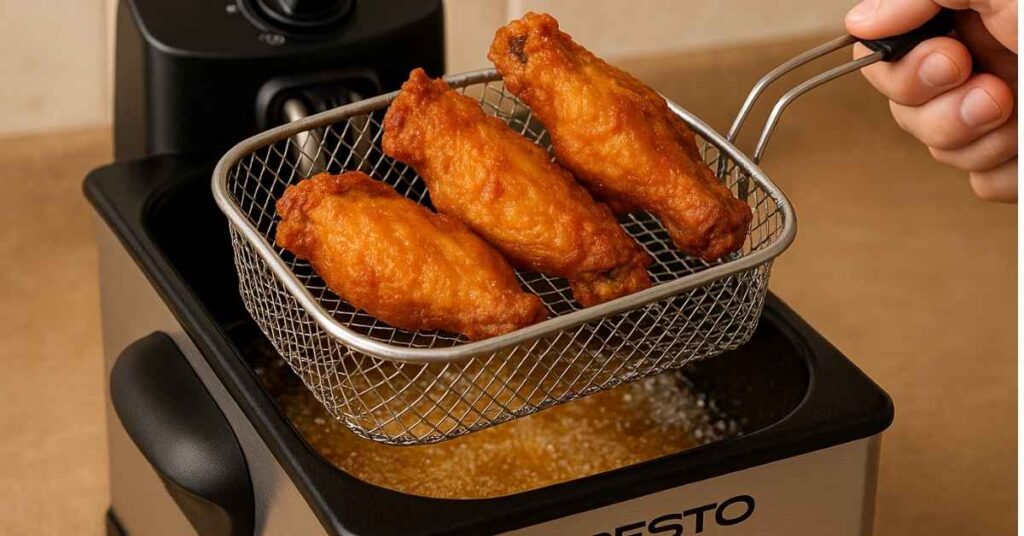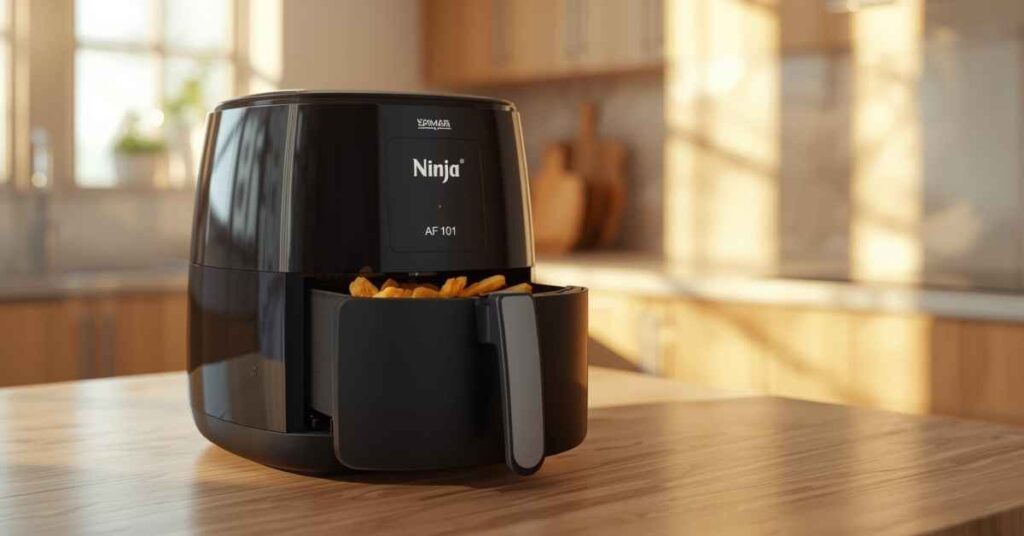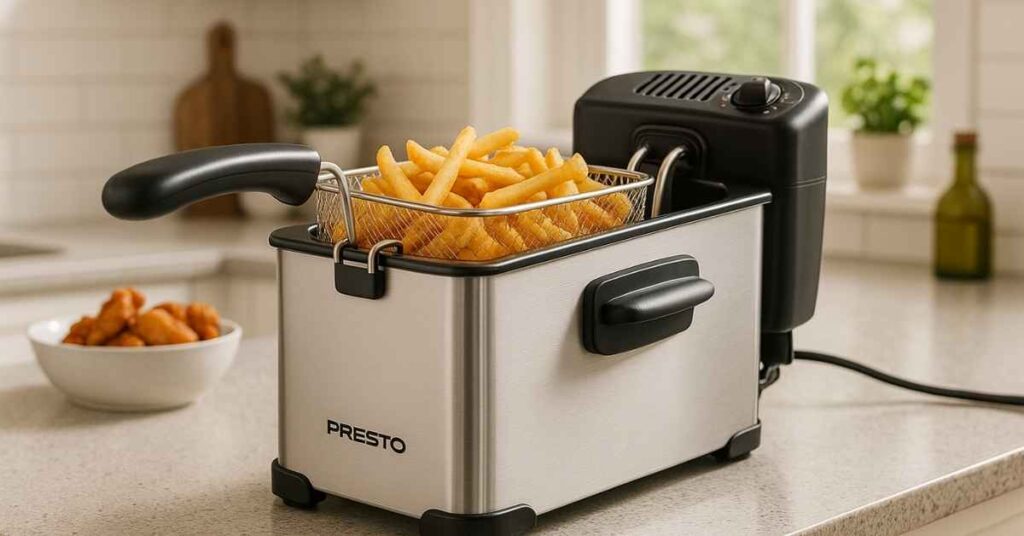When I first got my Presto deep fryer, the biggest question on my mind was simple: how much oil for Presto deep fryer? I didn’t want to overfill and risk splatters, but I also didn’t want to underfill and ruin a batch of fries. After testing, researching, and a few messy first tries, I figured out exactly how much oil you should put in a Presto deep fryer—and why it matters. In this guide, I’ll share what I’ve learned, compare it to other fryers (even air fryers), and give you some tips that will save you time, oil, and frustration. Stick with me, and you’ll be frying like a pro in no time.
How Much Oil Do You Put in a Presto Deep Fryer?
Most Presto deep fryers, like the popular GranPappy, take about 6 cups of oil (1.5 quarts)—just enough to reach the “MAX” fill line inside the pot. That line isn’t there for decoration; it’s your fryer’s way of saying, “Trust me, this is the sweet spot.” If you fill above it, hot oil can bubble over. Go below it, and your food risks coming out half-cooked or even burnt.
I learned this the hard way the first time I tried frying chicken wings. I thought a “little extra” oil would make them crispier. Instead, the oil bubbled up, hissed, and I ended up dancing around my kitchen with a roll of paper towels. Lesson learned: stick to the line. So, the short answer is—fill your Presto deep fryer only to the MAX line, usually 6 cups, no more, no less.
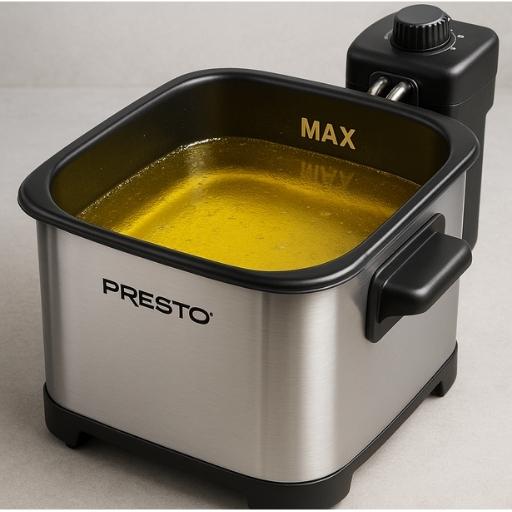
Always check your fryer’s manual too. Different Presto models may have slight variations, and the safest bet is to follow what the manufacturer recommends. Think of it like following grandma’s recipe—sure, you could improvise, but why risk ruining something good?
Why Oil Level Matters in Deep Frying
The amount of oil in your Presto deep fryer isn’t just about guesswork—it can make or break your frying game. Think of oil like the stage for your food. Too much or too little, and the whole performance falls apart. The right level keeps things safe, tasty, and perfectly crisp.
Safety comes first. When you pour in more oil than the MAX line, it doesn’t just sit there quietly. Once the food hits, bubbles rise, and hot oil can spill over. That’s a recipe for burns and a very messy kitchen. On the flip side, if you don’t add enough oil, your fryer works harder, overheats, and your food cooks unevenly. So, the short answer: always stick to the fill line—it’s there to keep you safe.
The oil level also controls temperature. With the right amount, your fryer maintains steady heat, which is the secret to golden fries and crunchy wings. Too little oil cools down fast when you drop in food, leaving soggy results. Too much oil can make it harder for the fryer to heat up evenly. Think of it like driving—too much fuel floods the engine, too little and you stall.
Flavor and texture depend on it. When the oil level is right, your food floats freely, fries evenly, and comes out crisp instead of greasy. That’s why restaurant fries taste consistent every time—they know their oil-to-food ratio. At home, hitting the right level gives you that same pro touch.
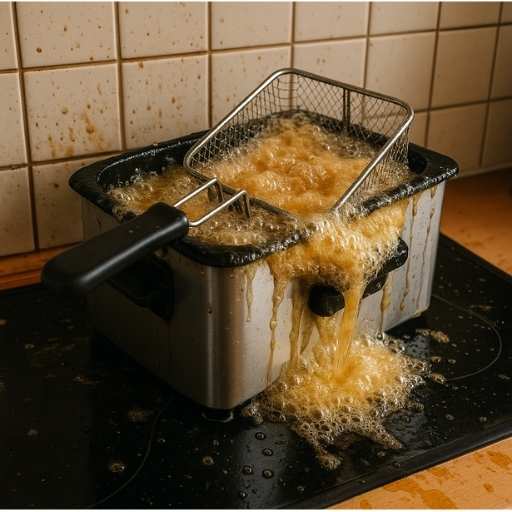
I learned this the messy way. One time, I thought I’d be clever and save oil by pouring in less than the line. Big mistake. My onion rings sank, clumped together, and tasted half-raw. Another time, I poured in extra oil for “extra crunch.” Instead, it bubbled over, and I nearly redecorated my kitchen walls with grease. Trust me—nothing humbles you faster than chasing hot oil with a mop.
In short: oil level matters because it keeps you safe, holds steady heat, and gives food the crunch you’re craving. Stick to the line, and your fryer will thank you with perfect fries every time.
Step-by-Step: Adding the Right Amount of Oil to Your Presto Fryer
When it comes to adding oil to a Presto fryer, the process is simple—but trust me, doing it right makes all the difference. Here’s the step-by-step method I follow every single time to keep my fries golden and my kitchen safe.
1. Place your fryer on a flat, heat-resistant surface.
Always start with the setup. Your fryer should sit on a sturdy countertop, away from curtains, kids, or anything flammable. Think of it like setting the stage before a performance—you want everything steady and safe.
Short answer: Put your fryer on a flat, safe surface before adding oil.
2. Find the oil fill line inside the fryer.
Presto makes this easy. Look inside the pot and you’ll see a clear “MAX” line. That’s not a suggestion—it’s a rule. If you pour more, oil will bubble over; if you pour less, your food may burn. I learned that lesson after a batch of half-cooked onion rings that looked sad enough to cry over.
Short answer: Always use the MAX fill line as your guide.
3. Choose the right oil for the job.
Canola oil is my go-to for everyday frying—it’s neutral, affordable, and dependable. Peanut oil shines when I’m frying chicken because of its high smoke point. And if I want that old-school diner vibe, beef tallow adds amazing flavor. Avoid olive oil or butter—they’ll smoke faster than you can say “fire alarm.”
Short answer: Use canola, peanut, or beef tallow—skip olive oil and butter.
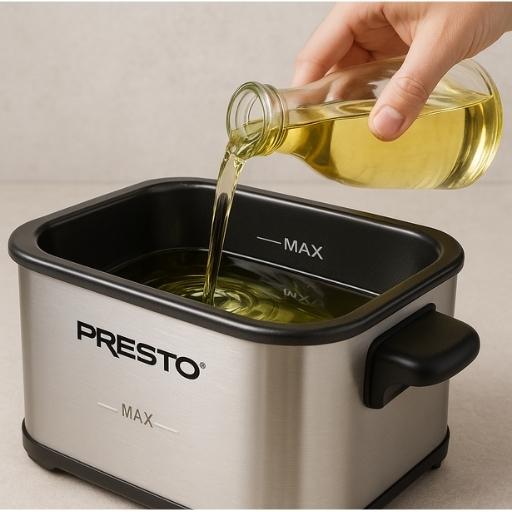
4. Pour oil slowly up to—but never above—the line.
This part is simple but requires a steady hand. Pour in your oil slowly and stop exactly at the line. Going over just a little may feel harmless, but I promise, you’ll regret it once it starts bubbling. I once ignored my own advice, and it felt like my fryer was plotting revenge with splatters.
Short answer: Stop pouring once you reach the MAX line—never more.
5. Preheat before frying.
Just like an oven, your fryer needs time to warm up. Give it a few minutes so the oil reaches the perfect temperature before tossing in your food. Drop fries in too early, and they’ll soak up oil like sponges. Wait, and you’ll get that crispy, golden magic we all love.
Short answer: Preheat your oil before frying for best results.
How Much Oil Do Other Deep Fryers Take?
Not all deep fryers are built the same, and the amount of oil they need can vary a lot. Small countertop fryers usually take about 1–2 quarts of oil, which makes them perfect for snacks or single servings. If you’re just frying a quick batch of onion rings or samosas for yourself, that’s all you’ll need.
Short answer: small fryers = 1–2 quarts.
Step up to a medium-sized fryer, and you’ll need more fuel for the fire. These hold around 3–4 quarts of oil, which works well if you’re cooking for a small family. When I used a medium fryer at a friend’s house, it felt like the perfect balance—enough oil to get crispy fries for everyone, but not so much that you felt wasteful.
Short answer: medium fryers = 3–4 quarts.
Now, when it comes to the big boys—like turkey fryers—you’re in a whole different league. These giants need a gallon or more of oil to fully immerse something as massive as a turkey. The first time I saw one in action was at a holiday cookout, and I couldn’t believe the amount of oil it swallowed.
Short answer: large/turkey fryers = 1 gallon or more.
Compared to these, a Presto deep fryer feels compact and practical. With just about 6 cups (1.5 quarts), it’s sized for everyday use—enough to make fries, chicken wings, or pakoras for the family without wasting oil. That’s one of the reasons I like it so much.
Short answer: Presto fryers = 6 cups, compact and efficient.
Presto Deep Fryer vs. Air Fryer: How Much Oil Do You Need?
A Presto deep fryer needs about 6 cups of oil (1.5 quarts) for proper frying, while an air fryer usually needs just 1–2 teaspoons. One uses immersion frying, the other relies on hot air circulation.
Now, if you’ve ever cooked fries in a deep fryer, you know the magic—golden, crispy, and that perfect fast-food taste. But here’s the trade-off: it takes a good amount of oil. On the other hand, my air fryer gives me decent fries with almost no oil. They’re lighter, crisp enough, but honestly? They don’t quite hit the same “crispy-crunchy outside, fluffy inside” level as the Presto.
When it comes to chicken wings, though, I’ll admit I cheat both ways. If I’m hosting friends, I pull out the Presto and go all-in with oil—it’s messy but worth it. For quick weekday cravings, I toss wings in the air fryer with a teaspoon of oil spray. They’re not as juicy, but they still satisfy without leaving the kitchen smelling like a fry shop.
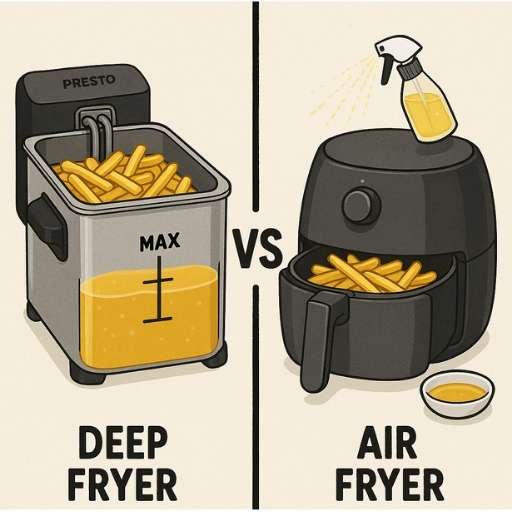
So, here’s the deal: use a Presto deep fryer when you want authentic fried flavor, but turn to the air fryer when you want something lighter and healthier with less cleanup. Both have their place, and honestly, I’d never give up either.
Best Oils to Use in a Presto Deep Fryer
Choosing the right oil for your Presto deep fryer is like picking the fuel for your car—it makes all the difference in how smooth the ride (or in this case, the fry) turns out. So, what’s the best oil to use? Let’s break it down.
Canola oil – the everyday hero
If you just want something affordable, neutral, and reliable, canola oil is your best bet. It has a high smoke point (around 400°F), which means it won’t burn easily, and it keeps flavors clean. I use it when I’m cooking for kids or guests who don’t want anything “too fancy.”
Short answer: canola is the go-to choice for simple, safe frying.
Peanut oil – the flavor booster
Whenever I fry chicken or fish, I reach for peanut oil. It has a higher smoke point than canola (about 450°F) and adds a subtle nutty flavor that makes fried chicken taste like it came from a Southern diner. The first time I tried peanut oil, my fries tasted so good that even cold leftovers disappeared within minutes.
Short answer: peanut oil is best when you want that extra punch of flavor and crispness.
Beef tallow – the old-school favorite
This one takes me back. Beef tallow is what McDonald’s originally used for their legendary fries, and for good reason. It gives food a rich flavor and holds up well to repeated frying. Plus, it’s more stable than vegetable oils, which means it doesn’t break down as fast. I remember frying homemade fries in tallow for the first time—it was like stepping into a time machine.
Short answer: beef tallow is the best choice if you want flavor and tradition in every bite.
Oils to avoid – butter and olive oil
It might be tempting to grab whatever’s in the pantry, but butter and olive oil don’t belong in a deep fryer. Their smoke points are too low, which means they burn quickly and leave food tasting bitter. I once tried frying zucchini sticks in olive oil (rookie mistake), and the whole kitchen smelled smoky within minutes.
Short answer: skip butter and olive oil—they’re better for pan frying, not deep frying.
Pro Tips for Using a Presto Deep Fryer
Using a thermometer is the easiest way to get consistent results. Most Presto fryers don’t have built-in temperature control, so a small kitchen thermometer makes sure your oil stays at the right heat. The correct temperature keeps food golden and crisp instead of soggy, and it saves you from guessing. I found this out the hard way when my first batch of fries came out pale and greasy—once I started using a thermometer, the crunch came every time.
Fry in small batches if you want food that stays light and crispy. When you crowd the fryer, the oil temperature drops fast, and the food ends up soaking in oil instead of frying properly. I once dumped in too many chicken strips at once, and they turned into oily sponges. Cooking in smaller batches keeps the heat steady, and the difference in taste is huge.
Don’t throw out your oil after one use if it’s still clean. Straining it with a mesh filter removes crumbs, and you can store it in a jar for another round of frying. This saves money and keeps flavors consistent. Of course, if the oil smells off or looks dark, it’s time to let it go. Fresh oil gives better taste, and reusing it a few times is safe when you care for it properly.
Always unplug the fryer when you’re done. Presto fryers don’t come with an on/off switch, so the only way to shut them off is by pulling the plug. I didn’t realize this the first time and left mine running longer than I should have. Now, as soon as I’m done frying, I unplug right away—it’s safer, and it helps the fryer cool down faster.
Conclusion
So, how much oil for a Presto deep fryer? The sweet spot is usually about 6 cups (1.5 quarts), filled right up to the MAX line. That little mark inside the fryer isn’t just a guideline—it’s your golden rule. Stick to it, and you’ll avoid messy splatters and get food that cooks evenly every time.
Of course, deep frying is one of those things best enjoyed in balance. I love making a batch of crispy fries or golden chicken wings on the weekend, but I also treat it as a special occasion, not an everyday habit. Think of it like going out for ice cream—you enjoy it more when it feels like a treat, not a routine.Now I’d love to hear from you: what’s your go-to oil when frying in a Presto deep fryer? Do you stick with simple canola, go bold with peanut oil, or keep it old-school with beef tallow? Drop your favorite frying recipes or oil tips—I’m always looking for new ideas to test in my own kitchen.
FAQs – How Much Oil for Presto Deep Fryer?
How much oil does a Presto fryer take?
A Presto fryer like the GranPappy holds about 6 cups of oil (1.5 quarts). Just fill it to the MAX line inside the pot. More oil can spill. Less oil can burn food. I once filled it too high, and oil bubbled everywhere. Not fun—stick to the line.
How much oil do you put in a deep fryer in general?
It depends on size. Small fryers need 1–2 quarts. Medium ones need 3–4 quarts. A big turkey fryer can use over a gallon. That’s why I like the Presto. It cooks well without wasting oil.
How much oil should you put in an air fryer?
Almost none. Air fryers use 1–2 teaspoons at most. You brush or spray it on. They use hot air, not oil, to cook food. I use mine when I want lighter fries. But for real crunch, the Presto still wins.
Can I use less oil than recommended in a Presto fryer?
No. Always use the fill line. Too little oil overheats and burns food. I tried it once to save oil. The fries came out soggy, and the smell was awful. Lesson learned—don’t skimp.
What’s the healthiest oil for deep frying?
Two good picks are beef tallow and peanut oil. They handle high heat and taste great. Canola oil works too. It’s cheap and neutral. For fries, I love beef tallow—it gives that old McDonald’s taste.
Read more Post:
- How To Clean Presto Deep Fryer
- Is Ninja AF101 Air Fryer Toxic
- Ninja AF100 vs AF101
- How to Use Presto Deep Fryer

Hello! I’m Rob Newaz, the creator of KitchKap. I built this site to share my passion for smart cooking, especially with air fryers and modern kitchen appliances. Here you’ll find easy air fryer recipes, honest appliance reviews, and practical cooking hacks. My goal is to help home cooks save time, eat healthier, and enjoy every meal with confidence.

